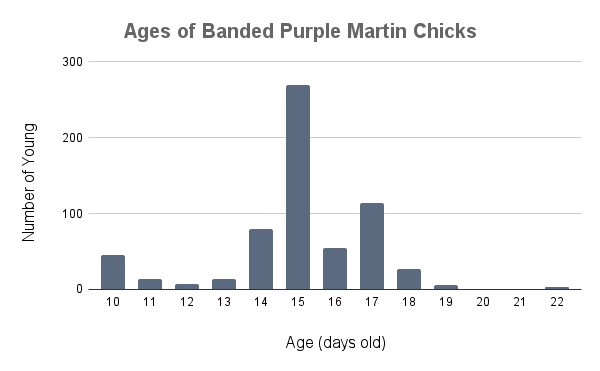Mark Martin and Dick Nickolai at the banding table on June 27, 2023 (photo courtesy of Mark Martin/Madison Audubon).
Around the beginning of July, I look forward to a call from Dick Nickolai, Wisconsin’s Purple Martin Biologist.
This year he called early and inquired if we would like to help him band martins in late June at the Amish community in the Dalton and Kingston area where Columbia, Green Lake, and Marquette counties meet. We banded on June 27th and 28th with four sessions at four Amish families’ homes. We will remember both days for their smoke advisories and very visible smoke from Canadian wildfires. We have never seen smoke this bad in the past.
Last year Emma Raasch wrote an excellent feature that details 2022 banding efforts. This year was our sixth year of banding with Dick and we followed past protocols. Over the past six years on 11 banding days, Madison Audubon has assisted Dick with banding 3,476 martins!
(Graph by Graham Steinhauer/Madison Audubon).
(Graph by Graham Steinhauer/Madison Audubon).
There are over 30 Amish families with Purple Martin boxes. The four residences that we banded martins at had a combined total of 22 T-14 boxes (308 nesting compartments) and 16 gourd apartments. This year, we tabulated 235 pairs of nesting birds. Of those nests, we:
Banded 653 young (158 nests)
Counted 140 birds under ten days old that were too young to band (38 nests)
Found 139 eggs (39 nests)
There were nests without eggs and young; we believe that some females were still initiating egg laying. Overall there were at least 1,263 individuals (470 adults and 793 young) at four Amish farms! Dick thought that the phenology was behind average by seven to eight days and that the cold and warm weather impacted egg laying.
Nest with eggs (photo by Carolyn Chee).
Nestlings (photo by Carolyn Chee).
Dick bands all adults and young at his main study area near High Cliff State Park and also bands martins at many areas throughout the state. Returning to the same areas gives him a good picture of the yearly phenology and how the statewide Purple Martin population is doing.
A young female Purple Martin recaptured in 2023 at the same location she was banded in 2022 (photo by Ashley Harbaugh).
The people of Wisconsin and the Purple Martins are lucky to have Dick. Since 1985 he has banded or caught recaptures of over 23,000 martins. This year, at the last box on the last day, Graham Steinhauer caught four nesting females. Two were at least two years old and two were one-year-olds, probably nesting late as they are known to do. One female was banded on July 13, 2022 at the same location!
Dick is one of our many members of our DNR family that we keep in contact with. In February, he called and asked me if I would like to go with him to the Amazon rainforest in Brazil to observe roosting Purple Martins. I passed on the offer but Dick went with a group for three evenings and watched 130,000 Purple Martins funnel down to roost on a small island in the Amazon. I look forward to seeing his writeup of this adventure!
One reason Dick is interested in Brazil is that biologists are trying to learn where our 10 to 12 million Purple Martins in the United States spend the winter. To help solve the mystery, Dick is placing 10 satellite transmitters on adult martins this summer. In addition to securing funds and doing all the paperwork he is also paying for 60 percent of the cost of the transmitters.
A just-banded Purple Martin chick held by a volunteer (photo by Becky Abel/Madison Audubon).
Banding Purple Martins is a team project. Thanks to everyone for helping out including Dick; the Harley Bontrager, Harley and Ora Mast, Jacob Petersheim, and Ervin Yoder Amish families who maintain the martin boxes; the Madison Audubon volunteers and Amish kids who assisted with bringing birds to be banded; Graham Steinhauer, Emma Raasch, Carolyn Chee, and Miles Roth, who lowered and raised the boxes; and Brenna Marsicek and Becky Abel for lining up volunteers. The three young volunteers and 11 Amish children did an excellent job in holding the birds while they were being banded.
I am looking forward to banding Purple Martins next summer.
Written by Mark Martin, Goose Pond Sanctuary resident manager & Purple Martin data recorder
Cover image by Mark Martin/Madison Audubon. A group of staff and volunteers stand amidst a Purple Martin colony during one of the banding sessions.
**All banding, marking, and sampling is being conducted under a federally authorized Bird Banding Permit issued by the U.S. Geological Survey’s Bird Banding Lab.












